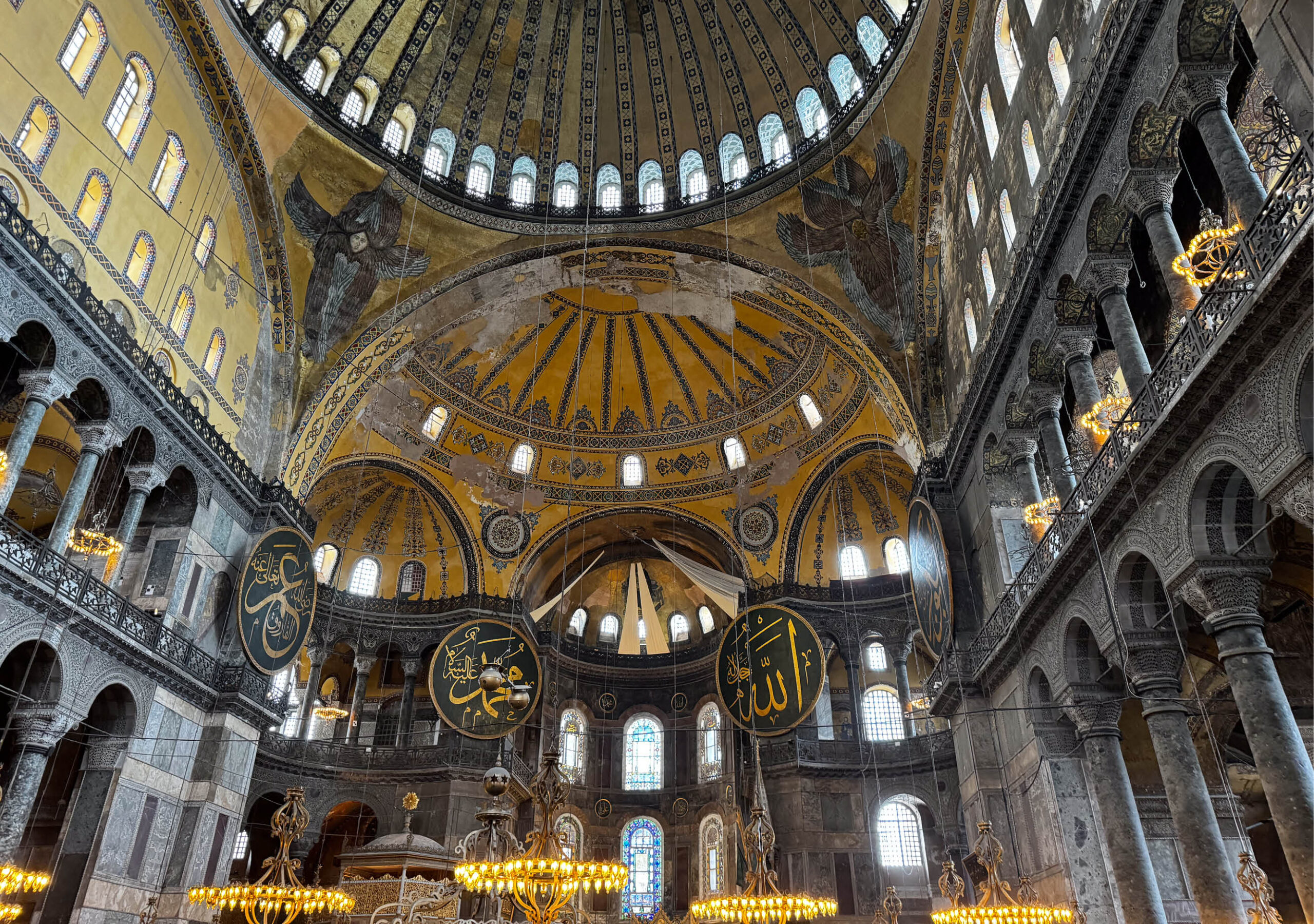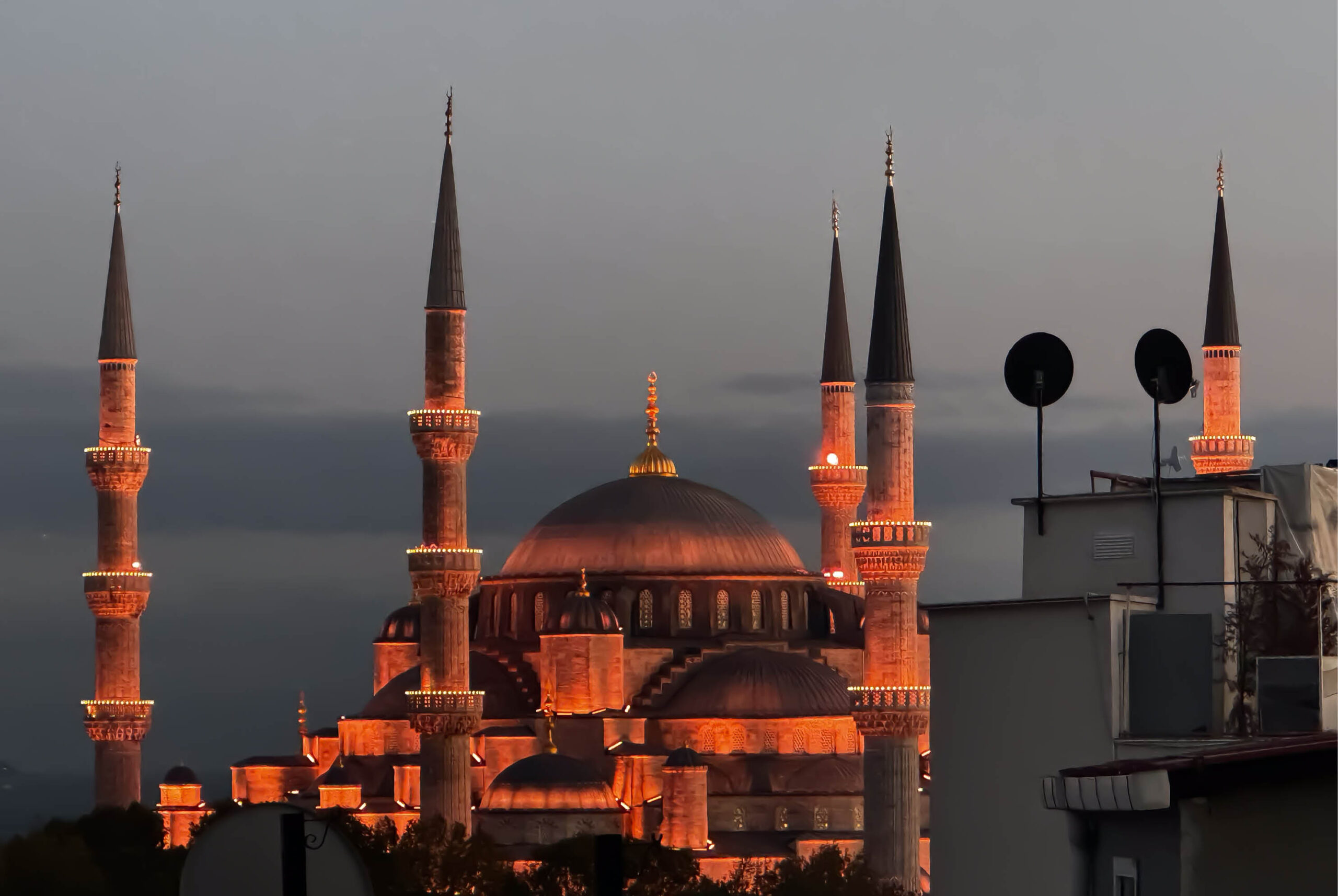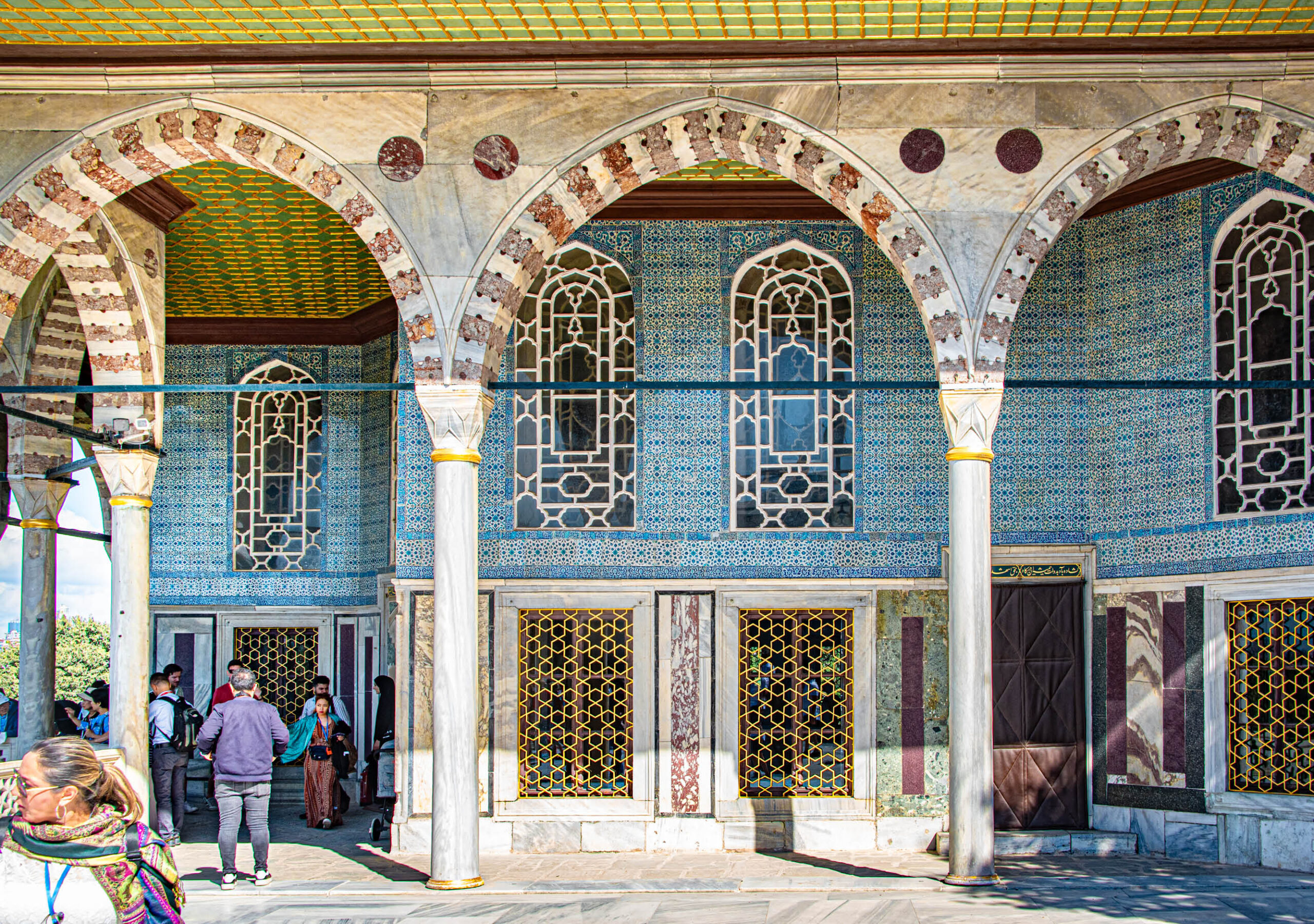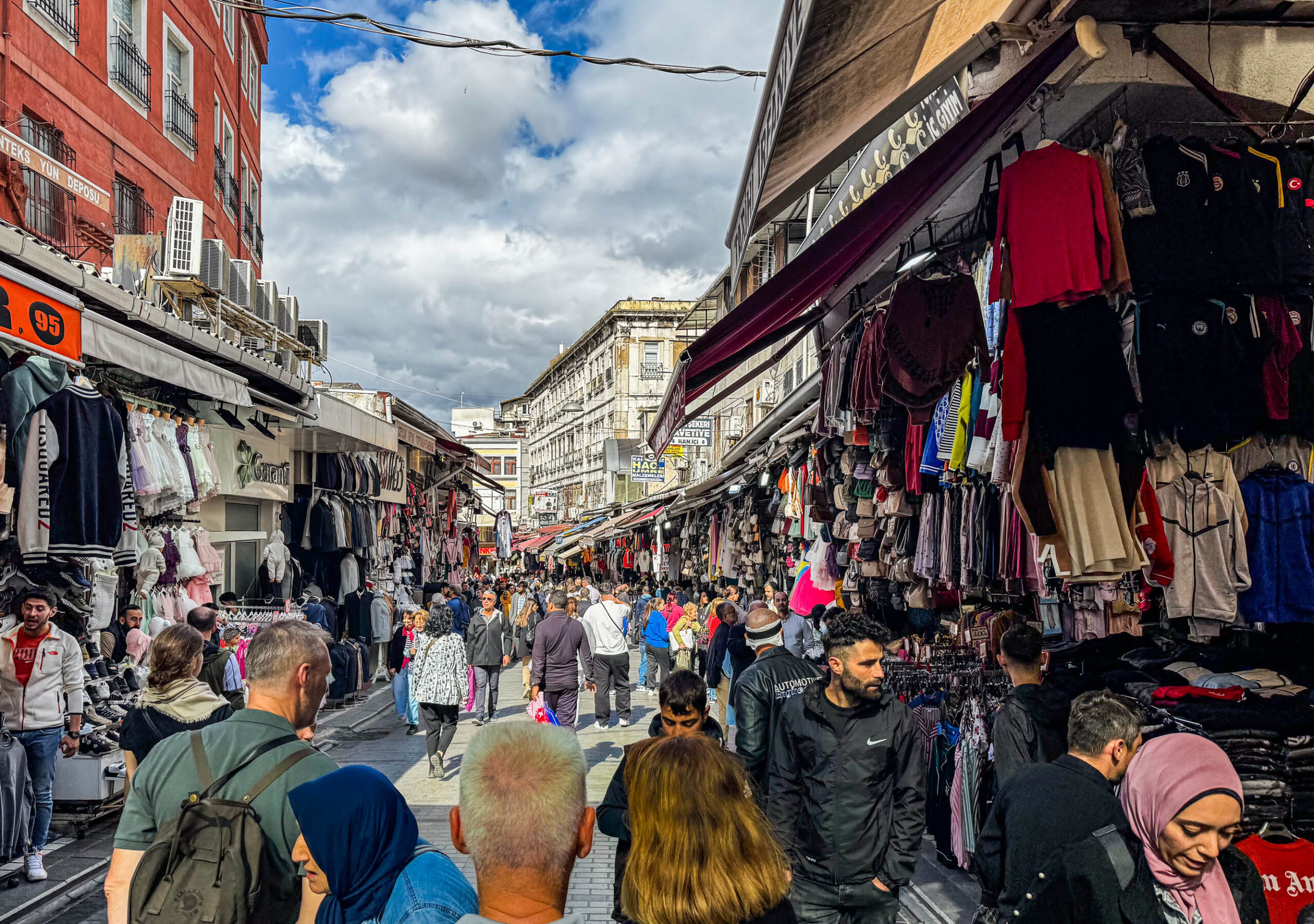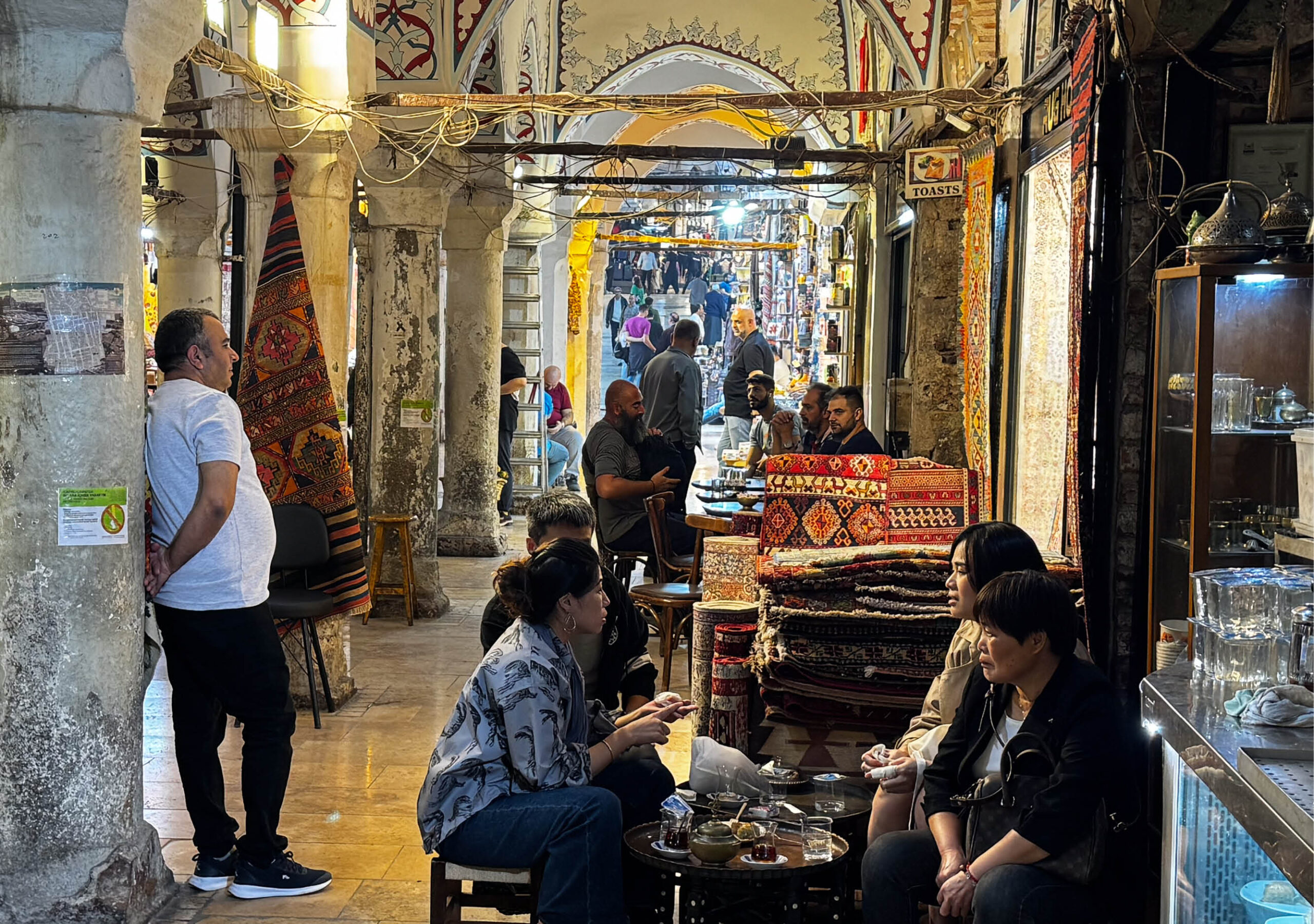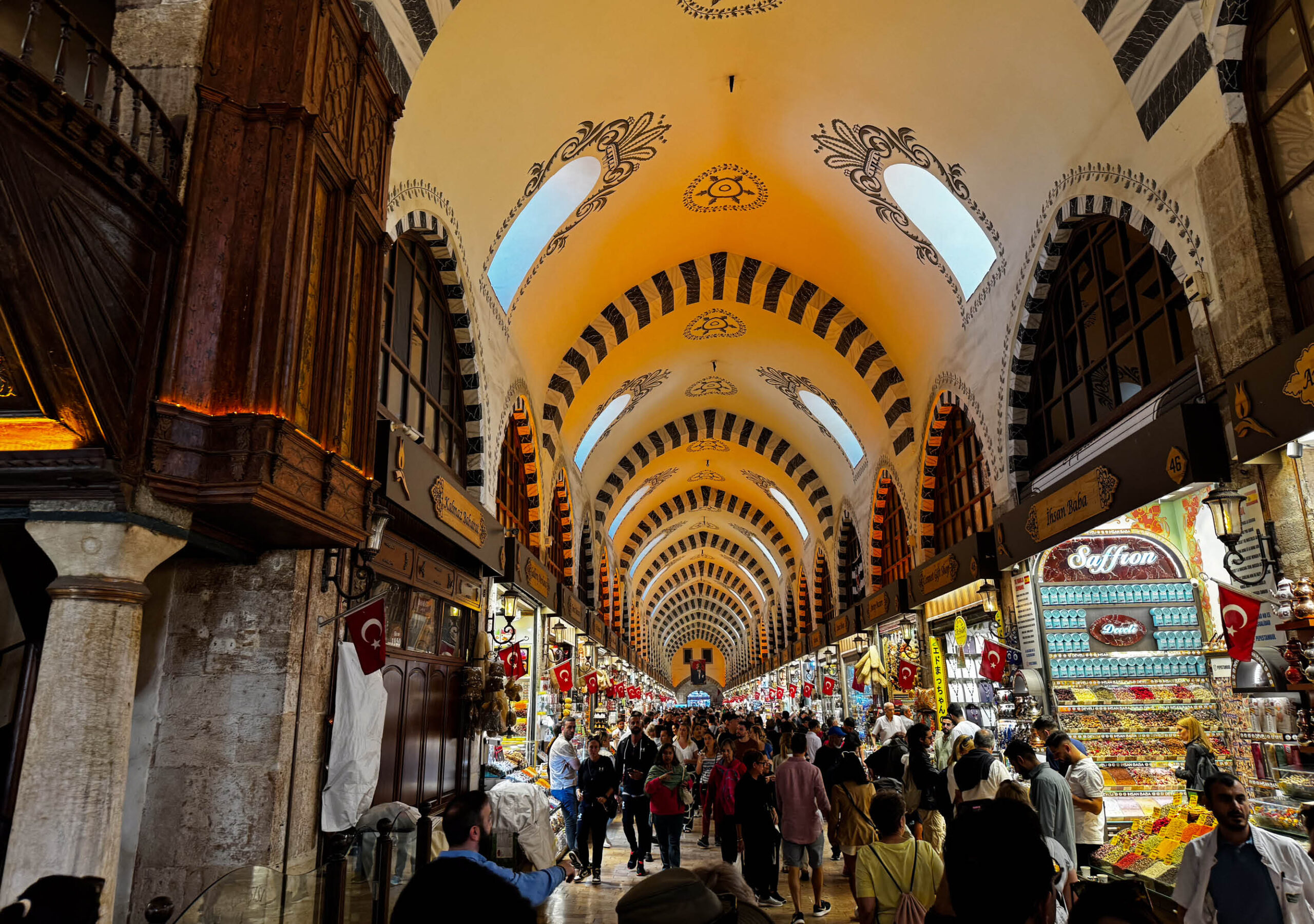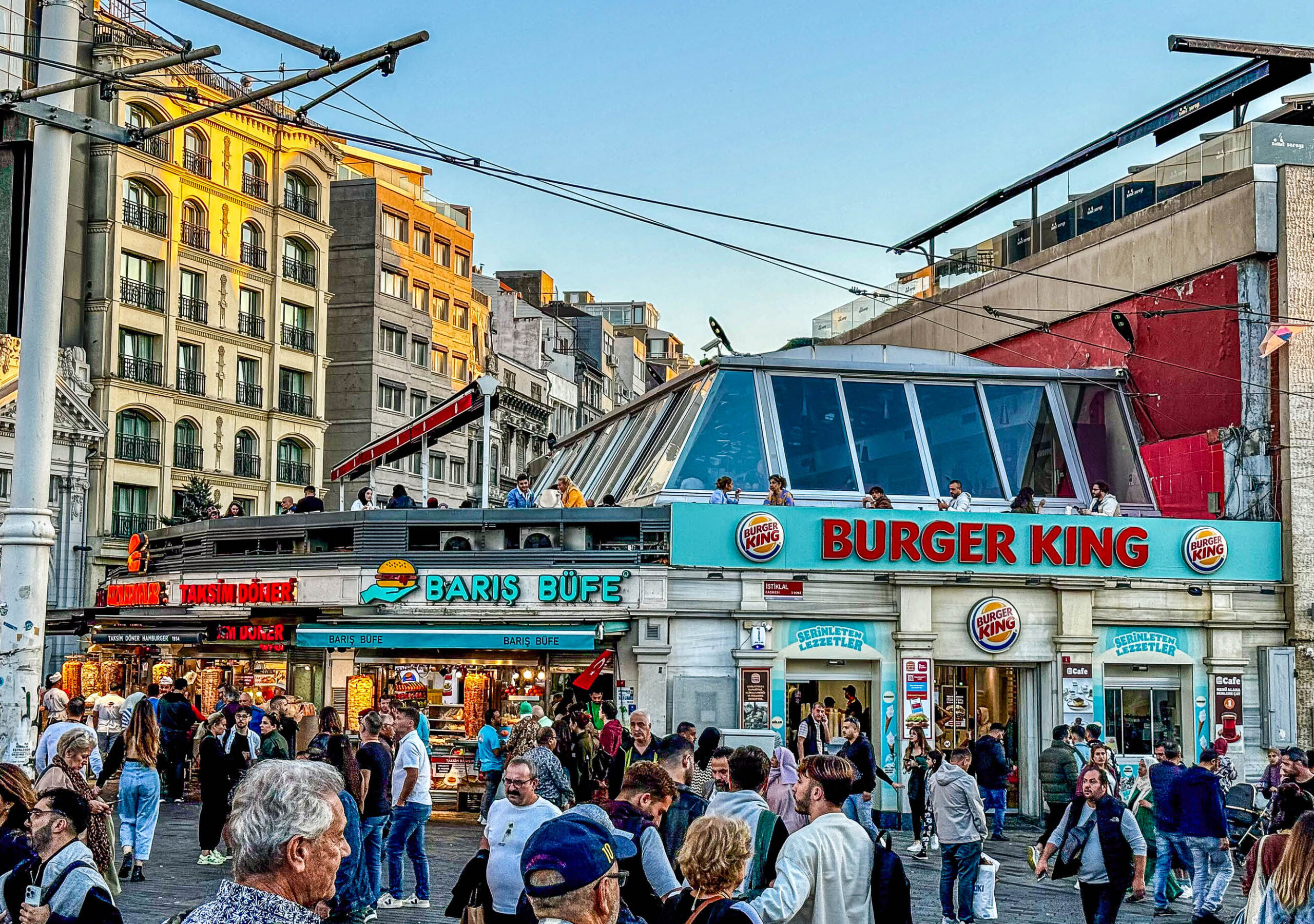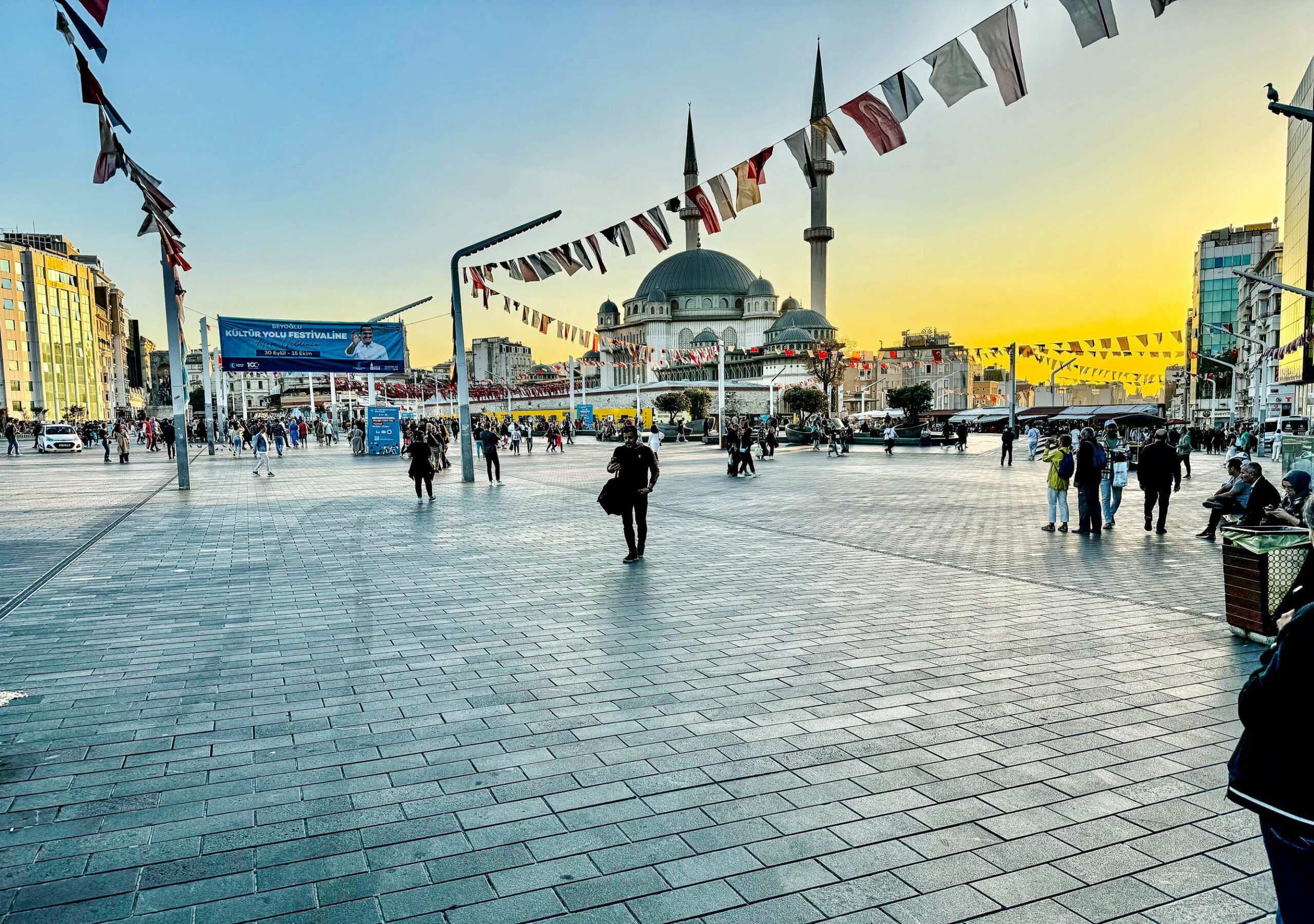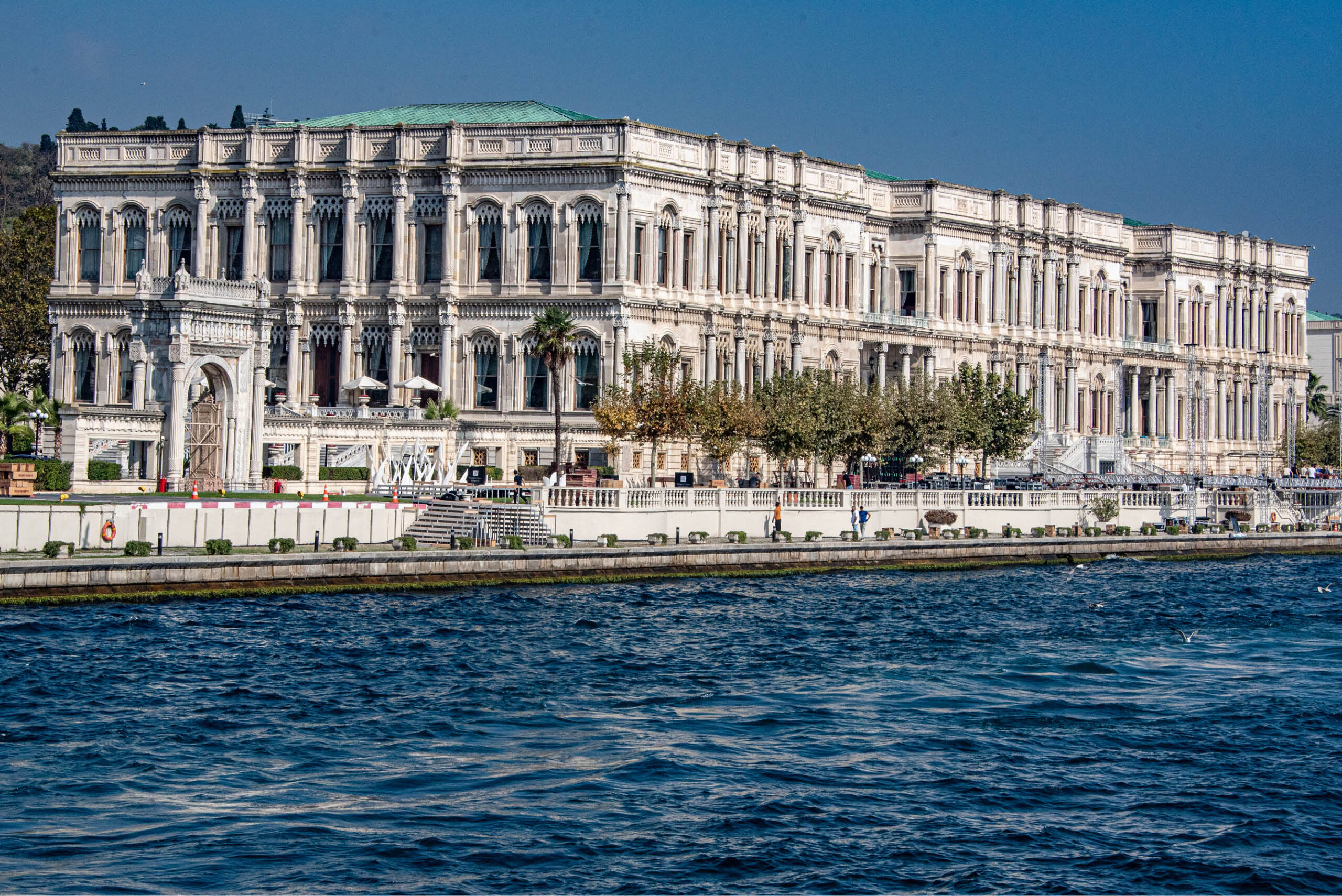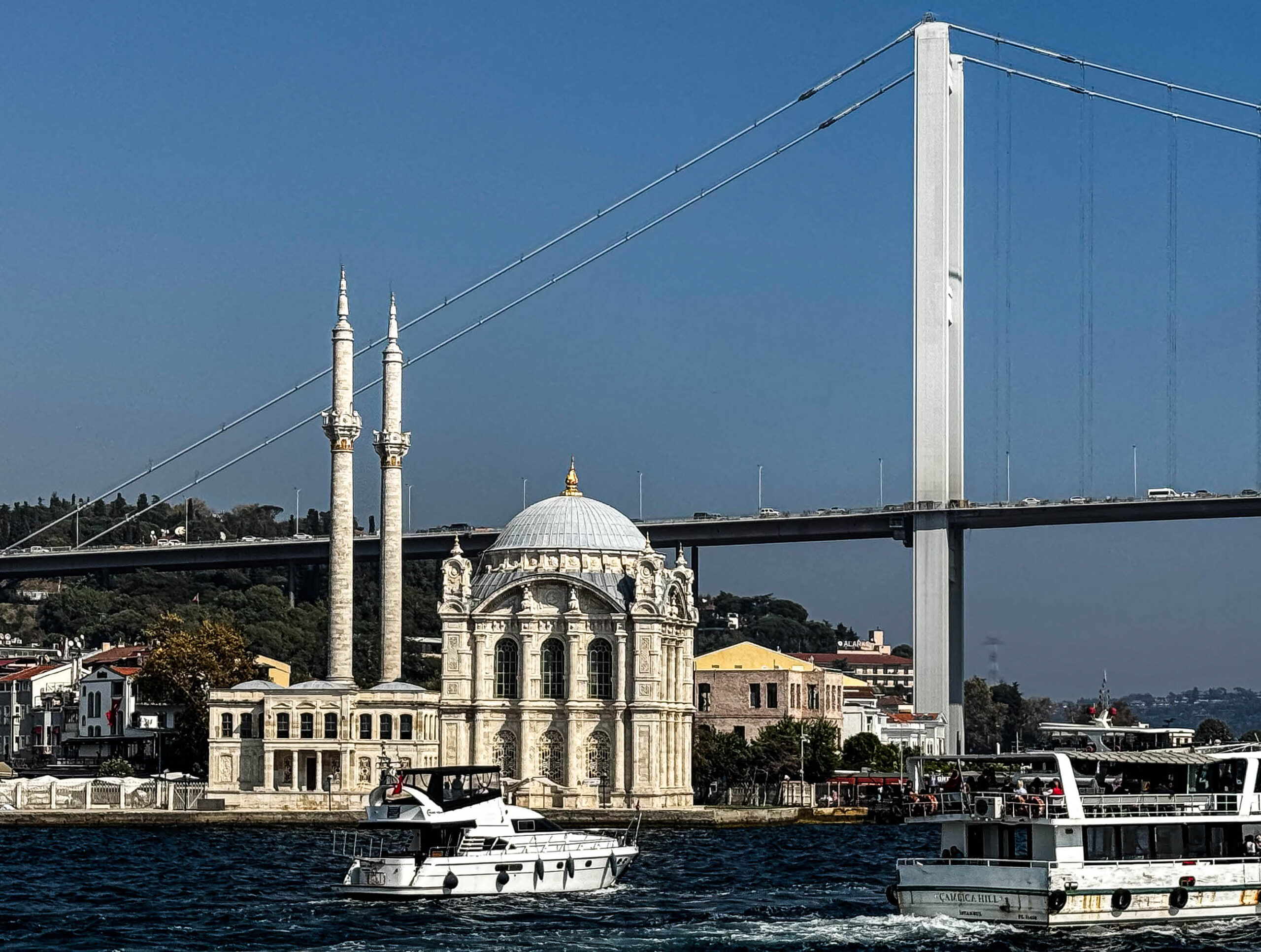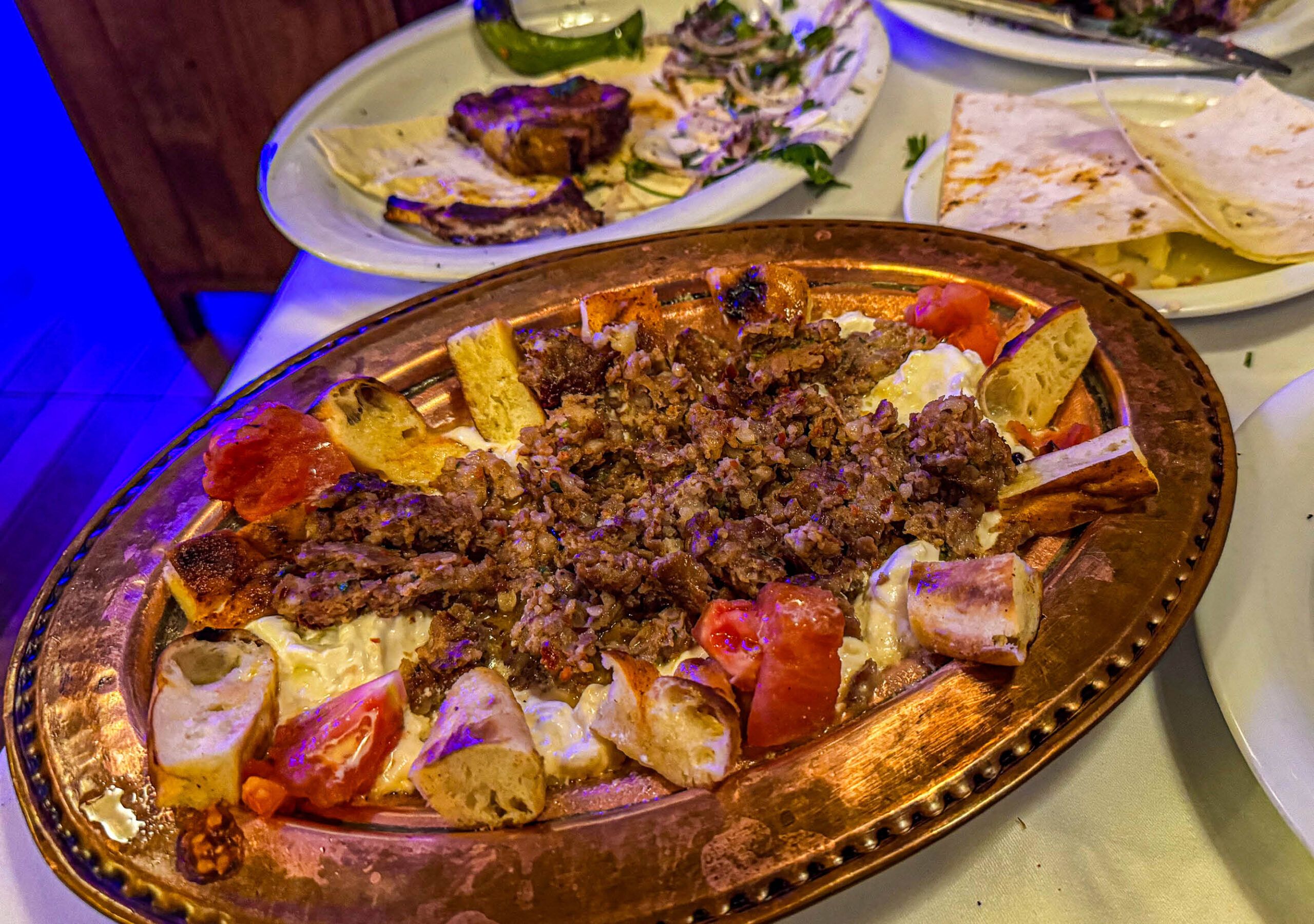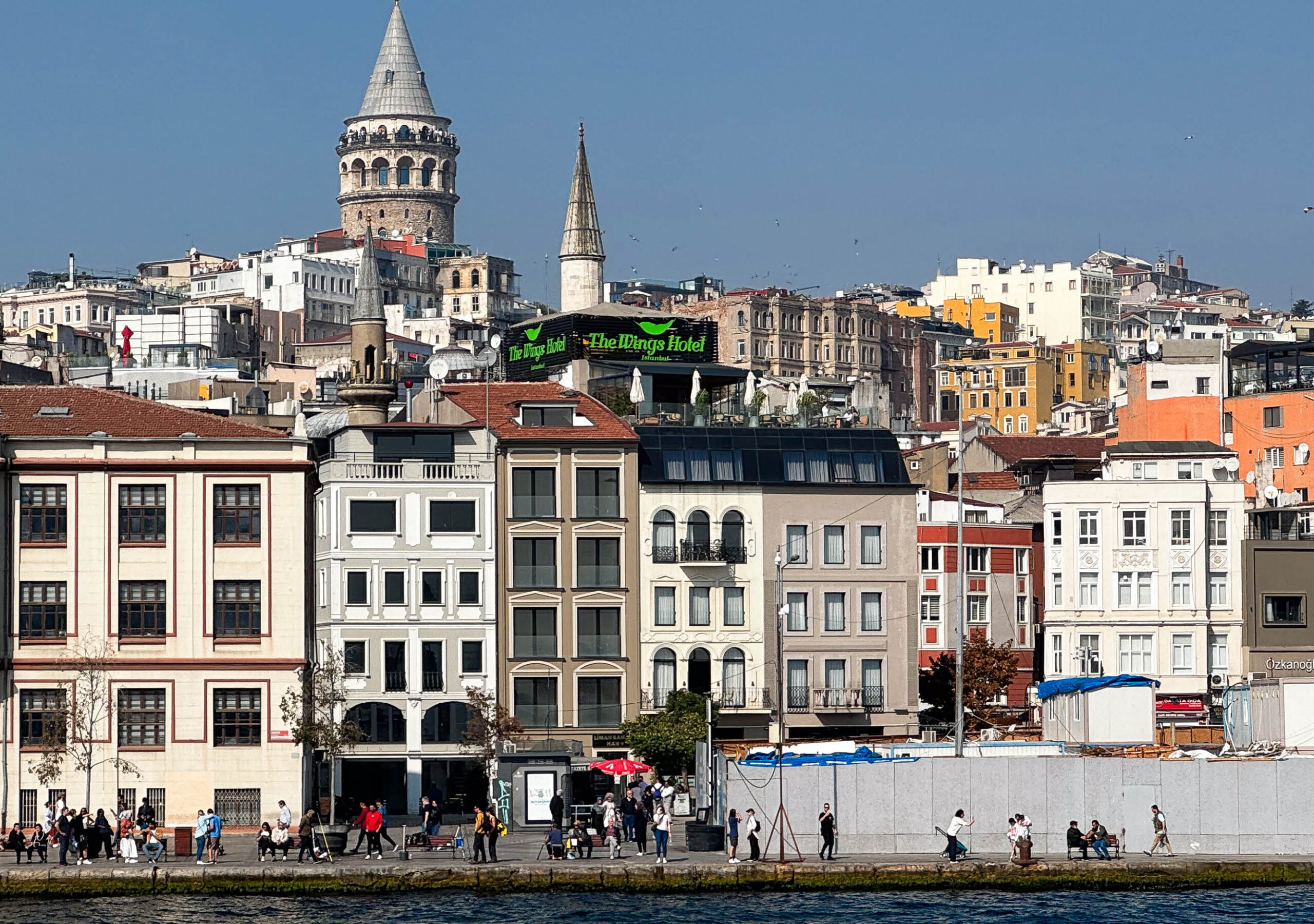Pictured above: The Blue Mosque glows in the early evening’s light.
When war broke out October 7, 2023 between Israel and Hamas, the event truncated our plans to return to Tel Aviv after an exciting four-day adventure to Jordan. The outbreak shook our “travel mojo,” and we needed to leave the region as soon as possible. Our travel company, London-based Out Of Office, contacted us immediately, and at our request booked us on a flight from Amman, Jordan to Istanbul.
I’m not usually a “slow travel” kind of guy. I anticipate a full schedule of places to see, adventures out of the ordinary to enjoy, and new people to encounter along the way. I take lots of photographs and record the day’s experiences in a journal. Yet, with no itinerary other than to meet four friends for a Viking Cruise sailing from Istanbul five days later, we found ourselves with the luxury of time to spend as we wished in “the city of the world’s desire.”
“Istanbul was Constantinople
Now it’s Istanbul, not Constantinople
Been a long time gone, Constantinople
Now it’s Turkish delight on a moonlit night”
Rick and I visited Istanbul for two nights 25 years ago on our first trip together soon after we met. Ever since, the city floated above the clouds in my imagination, bathed in a romantic mystique. “We have to get back to Istanbul,” I often whispered to myself. And here we were.
We booked the Tan Hotel located in a warren of charming small streets in Old City’s Sultanamet District. Our modest top-floor room included a generous private balcony with chairs, sofa, and cocktail table and a jaw-dropping view of the Blue Mosque, with the Marmara Sea and Golden Horn waterways in the distance––a surprising “room with a view.”
How we spent five days in Istanbul
Istanbul provides bountiful opportunities to amaze, entertain, and enjoy oneself. With five days to spend, we had lots of adventures; but we also devoted time to relax and watch this Euro-Asian city unfold.
From our two visits to Istanbul, I created five kinds of activities I recommend first time visitors consider in allocating their time to enjoy the city’s magic. The first two are loaded with options, so depending on the length of your stay, you may need to pick and choose. So difficult to do!
1. Historic Sites
One could spend days wandering through mosques, palaces, museums, and fortresses covering more than almost two millennia of history. Here are our “must-see” biggies to include in your sight-seeing list, all located in the Old City. Start early in the day to make your visits. Even in mid-October, the city and its sites were jam-packed with travelers from across the globe.
The haunting melodies of the muezzin’s calls to prayer from minarets at the city’s mosques five times daily (now mostly pre-recorded) strikes a deep spiritual chord and momentarily transports me to a place beyond. Mosques are closed to visitors during those times, so plan your visit accordingly. We didn’t; we waited an hour in a long line to enter Hagia Sophia. Still worth it!
As in all mosques, we removed our shoes, and stored them in provided racks. Long pants only, please, and women must cover their heads and upper arms. A docent gently stopped those without head coverings. We witnessed one western woman in line to view the Blue Mosque reach inside her blouse, unsnap her bra, and remove it to place on her head so she could enter.
Hagia Sophia Grand Mosque
For me, it’s the second most beautiful building I’ve had the pleasure to see (hats off to #1, India’s Taj Mahal). Built as a church in 537 A.D. by Emperor Justinian, the Ottomans converted it into a mosque in 1453. It remained so until 1935, when the government of the new Republic of Türkiye declared it a museum. In 2020, the Turks changed their minds again, and now it’s one of the city’s most important Islamic places of worship.
Hagia Sophia is the epitome of opulent Byzantine architecture, an architectural marvel for centuries for its soaring pendentive dome. The Ottomans further expanded and embellished the building over five centuries with Islamic design and construction elements to enhance its unique, vast, mesmerizing interior space.
Blue Mosque (Sultan Ahmed Mosque)
Situated across an attractive park and fountains from Hagia Sophia, the interior walls of the Blue Mosque feature beautiful painted Iznik tiles with blue floral motifs. Built by Sultan Ahmed in 1617, its six minarets surround the central dome and its four semi-domes; the complex surrounds a large courtyard as big as the mosque itself.
With its location near Hagia Sophia and on the grounds of a former sprawling complex with a Byzantine palace, Sultan Ahmed wanted to assert the dominance of Ottoman and Islamic culture over its Roman and Orthodox predecessors.
Both mosques will take your breath away. As dusk arrives, dramatic lighting illuminates these two structural beauties. Sit in the middle of Sultanamet Square (the park between the mosques), and if you time it right to be there for the evening call to prayer, you can dream the fantasies of 1001 Arabian Nights.
Topkapi Palace
Another magnificent complex and the scene of fables, mysteries, and intrigues. Ottomans built the palace in the fifteenth century, serving as the dynasty’s court for all official business as well as residences for the royal family, viziers, and other members of the sultan’s coterie. In 1856, the entire royal household and government then moved to Dolmabahçe Palace (which you can see on the boat tour described below), and the new Turkish government converted Topkapi into a museum in the twentieth century.
Situated at the promontory overlooking the Golden Horn waterway and Bosporus Straight behind Hagia Sofia, the 170-acre, 400-room mega complex housed up to 4000 people, including 300 concubines in the harem, and over 250 eunuchs. (In later years, sultans transformed the body of eunuchs from Eastern Europeans to all Black Africans). Eunuchs also controlled the Queen Mum’s affairs and finances.
Four stately courtyards, opulent pavilions, the jewel-filled treasury (including the Topkapi Dagger), private residences, buildings displaying the sartorial splendor of the period, weapons and armor, the palace commanded our attention for several hours. Then there’s the official Circumcision Room, where, according to traditional Islamic custom, boys submitted to the procedure before they entered puberty. The room was closed during our visit.
Basilica Cisterns
We visited this underground wonder located near Hagia Sophia on our first trip, moving through the cavernous space on up-lighted walkways. The 336 columns holding up the structure originally came from temples and other public buildings Emperor Justinian appropriated in the sixth century. Istanbul once had several hundred cisterns, this the largest, to supply water to the city’s inhabitants. You’ll be in for an eerie and atmospheric experience.
2. Istanbul's Markets
I’m cheating here, because one of these markets, the Grand Bazaar, is routinely included among the top five historic sites to see in this part of town. Yet the experience is completely different, because if you are blessed with a shopping gene like us, you’ll be an active participant as well. Two covered markets are worth exploring, as well as the open-air streets lined with stores and stalls that connect the two.
Grand Bazaar
First of all, don’t expect to easily exit the market the way you enter, since there are 21 gates for this structure that covers 61 streets and houses 4000 shops. Daily traffic can run between 250,000 to 400,000 visitors on a busy day. In 2014, Travel & Leisure Magazine named the Grand Bazaar the numero uno tourist attraction in the world, at over 90 million people annually. But don’t let that scare you off. The day we went, the Bazaar was no more crowded than a popular western mall.
The Bazaar (parts of the structure date to 1456) is a fascinating lens into the arts, crafts and culture of ancient and modern Istanbul. Look up at the vaulted ceilings. The freshly repaired and painted surfaces, now handsomely decorated with floral motifs, are part of a multi-year restoration project. Some upscale stores line the broader upper halls, but stalls selling more indigenous goods dominate the mix.
Be smarter than we were. Grab a map that will orient you to the layout and will also indicate sections of the Bazaar devoted to certain trades––carpets, jewelry, shoes, handmade ceramics, copperware. We took the “just wander” approach, winding our way into the old parts of the Bazaar consisting of narrow walkways, columns, and older established stalls selling local goods, more carpets, more jewelry, and handmade trinkets.
The Bazaar slopes downhill. We followed that direction and emerged from the covered market to a series of open-air market streets, filled with local shoppers buying everyday stuff, produce, clothing, and street food for local consumption. Continuing down the hill towards the Golden Horn waterway, we came to the other covered market worth exploring…
Egyptian Bazaar
Locally known as Misir Çarşisi, or the Spice Market, built in the 1660s as part of the New Mosque Complex. Another beautiful interior, the building houses 85 stalls selling spices and herbs, Turkish delight and other sweets, dried fruits, nuts, and potpourri.
I bought a spicy Turkish barbeque rub recommended by the shop owner; a jar of sweet-smelling saffron; and za’atar, the Middle Eastern mixture that has sumac as an ingredient, along with varied combinations of ground oregano, thyme, marjoram, cumin, and coriander.
3. Modern Istanbul
Taksim Square
It’s not full of historic sites, nor is it a warren of winding medieval streets and buildings. Yet Taksim Square area provided an exhilarating late half-day immersion into modern Istanbul. Located in the city’s European side across the Golden Horn, this sprawling open space, marked by the Republic Monument that honors the creation of the modern state of Türkiye in 1928, is the center of twenty-first century Istanbul.
Filling the ground floors of attractive nineteenth century structures along famous Istiklal Caddesi (Street) are restaurants, cafes, bars, cinemas, live music, and retail stores of many international brands. Vintage trams ply the otherwise pedestrian avenue that runs off the Square next to Taksim Mosque. Istanbulites come to Taksim Square to have fun and play.
Time to shop! We bought dress shirts and sweatshirts, outerwear, jackets––our first real personal shopping event of the holiday. Then thirst and hunger captured our attention as dusk settled.
The side lanes of the neighborhood lit up with lights strung across streets as diners filled sidewalk restaurants. The owner of Zubeyir Cakbasi Restaurant sat us inside since we didn’t have rezzies, yet the liveliness of other guests created a party atmosphere that complimented my scrumptious plate of ali nazik, eggplant puree with minced lamb. Seated at the next table, a Muslim Kurdish family celebrated the eighteenth birthday of their daughter. They shared the birthday cake to celebrate and honor her. Tebrikler! (Congratulations!)
I wish we had read more about the area before wading into it. We missed the Whirling Dervish Museum, the historic Flower Passage arcade, and a famous old-time movie theater. My list of things to see for the next visit grows.
4. Istanbul by Boat
Visitors can’t say they’ve been to Istanbul if they fail to take a boat ride on the Bosporus Straight. For our two Istanbul visits, we boarded a municipal ferry the first time and a chartered boat this go-round for a two-hour boat ride to enjoy the unmissable vistas of both the European and Asian continental edges.
Istanbul blankets seven hills, and there’s no better way to appreciate this cityscape than from a boat gliding along the blue waters of this very busy waterway. Densely built neighborhoods, mosques, palaces, museums, fortresses, civic and commercial buildings slope up the steep inclines away from the shore, evoking a scene from a Maxfield Parrish painting.
Leaving from the Eminönü terminal on the Old City side of the Golden Horn, boats first glide northward along the European shoreline, returning on the Asian side. We made sure to sit on the boat’s benches on the left facing the bow (port side) for the best views.
Popular Beştiktaș district, a commercial and residential hub known as little Europe, boasts famous Dolmabahçe Palace on the water, which served as the Ottoman Empire’s administrative center after Topkapi Palace was abandoned in mid-1800s. Stunning Ortaköy Mosque nearby gleams in the sunlight as we glide by.
The charm of the art nouveau style residences and commercial buildings of the Arnavutköy district shows off along the waterfront. Further along near the tour’s turnaround point at the Fatih Sultan Mehmet Bridge, imposing, well preserved and handsome fifteenth-century crenulated Rumeli Fortress dominates the waterfront. Returning on the Asian side, impressive Beylerbeyi Summer Palace and the Kücüksu Palace, a summer hunting residence, both built for Ottoman nobles, prominently sit along the water.
On our next visit to Istanbul, we’ll take ferry boats that stop at terminals up and down the Strait on both sides, where we can disembark and explore these fascinating neighborhoods and historic sites.
5. Relaxing and Dining in Istanbul
Downtime––that’s the special gift we gave ourselves on this “slow travel.” Each day we stopped being tourists around 1300 hours (1:00 p.m.) and found an outdoor café for a leisurely lunch, which invariably included a mug of Efes Pilsen lager or glass (or two) of local wine to complement the kabobs, felafels, minced meat, and grilled vegetables that formed our basic culinary selections. And we watched the lives of tourists and locals flow by, feeling as if we somehow live here, too, however briefly.
Near our hotel, several small restaurants with outdoor tables line the small lanes off Divan Yolo Caddesi, one of Old City’s main tram streets. Massa Restaurant’s owner welcomed us on two occasions, seating us at tables with red-cushioned benches close to the walkway, a perfect vantage point for people-watching. Like a scene from a movie, tourists darted in and out of shops, locals carried shopping bags, an old woman toted her overloaded cart of belongings, and sellers plied their wares.
One of Massa’s waiters performed a traditional ritual, serving a dish called chicken testi baked in a sealed clay pot. Once fully cooked, he heated the container over an open flame, then held it high with a cloth, tapped the top with a large metal spoon until it popped off for serving. Diners applauded.
On another day, we found ourselves dockside along the Golden Horn waterway in the Eminönü neighborhood near the Galata Bridge. The Bridge connects the Old City with its new city counterpart to the north, both located on the European side. Beneath the driving lanes, tram lines and pedestrian walkways, a string of seafood restaurants hugs a lower tier behind a walkway and railing along the water. Freshly caught sea bream that morning highlighted the menu.
The scene before us as we sipped wine and dined: watching the choreography of boats docking and sailing from the ferry terminal next door. Punctuating the scene, fishing lines dropped down from the bridge’s top tier, where fishermen line up every day along the railing to try their luck with waters rich with sea life.
Guilty pleasures for travelers in the form of naps usually followed these dawdling lunchtime experiences. What an indulgence, after the hard work of “touristing,” to be able to recount the morning’s activities as I drift off.
And I know what awaits in the evening––climbing hilly streets to explore a new neighborhood in search of that restaurant I identified on the internet or recommended by hotel staff for another atmospheric evening of modestly priced wining and dining. One evening we watched the waiter at the table next to us first prepare, then stoke a gigantic hookah for five diners to share with their dessert, a tradition originating in the East.
Istanbul Stimulates the senses
It’s easy to feel like a whirling dervish trying to absorb the essence of “the crossroads of the world.” A more leisurely approach afforded a deeper appreciation of the city’s panoply of historical and cultural riches. The art of this “slow travel” is to balance the more time-consuming visits to incredible must-see sites (throngs of visitors, babel of languages) with “beneficial inactivity” to round out one’s total experience.
You won’t regret treating yourself to leisure time like this on your next adventure. It will allow you to savor your discoveries and appreciate the privilege of travel.
Post script: It’s been a few months since this trip. I fell in love all over again with magical Istanbul. It fails to disappoint. And yet I still whisper to no one but myself, “We have to get back to Istanbul.”
If You Go
- Getting There:
- Only Turkish Airlines (ranked sixth best worldwide) flies non-stop from USA to Istanbul Ataturk Airport from 12 cities: East Coast from Boston, New York Kennedy, New York Newark, Washington D.C. Dulles, Atlanta, and Miami; Midwest from Chicago, Dallas/Fort Worth, and Houston; and West Coast from Los Angeles, San Francisco, and Seattle.
- 1-stop to Europe, then to Istanbul is a common route and tons of options
- Round trip coach from the East Coast––$900 to $1050
- Take the metro or taxi into town
- Getting Around:
- By tram, metro, bus, and ferry boat––interconnected public system, inexpensive, extensive, and efficient. Pick up system maps at major public transport stations
- Purchase an Istanbulkart card—sold at major metro and tram stations, a plastic chip card that travelers load money onto at electronic machines located at all stations and used at all these transportation modes.
- Buses travel all through the city and suburbs, except in historic Sultanamet District. Only trams service this area.
- Public ferries—called Şehir Hatlari (City Routes), ferry boats visit 45 docks on both sides on the Bosporus, and visitors can get on and off to explore. The ferries also have a 90-minute tour up and down the Strait. Typical commuter ferry ride to another stop averages $.50.
- Taxis—these bright yellow vehicles operate 24 hours daily. Uber is also an option (and comments by riders say it’s safer, though we didn’t have a problem).
- On Foot—walk as much as possible to discover the city. It is very hilly so take your time to explore.
- Admission Prices (for sites we visited):
- Topkapi Palace––beginning January 1, 2024, one ticket covers the entire facility, including the harem for about $50.
- Basillica Cisterns––as of January 1, 2024, tickets are about $20.
- Hagia Sophia Grand Mosque, Blue Mosque (Sultan Ahmed Mosque), Grand Bazaar, and Egyptian Bazaar––no fee
- For other palaces and museums, check their admission prices online.

